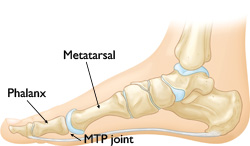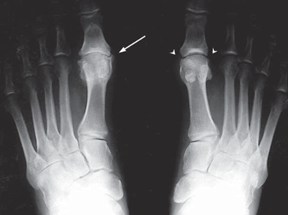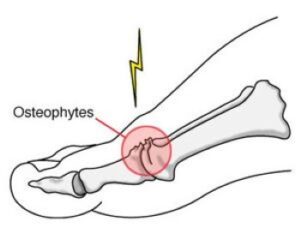Patients with hallux rigidus often develop a bump on the top of the foot at the base of the big toe (white arrow).
Doctor Examination
If you experience difficulty bending your big toe upward or downward or notice that you are altering your gait by walking on the outer edge of your foot to avoid toe pain, it is crucial to consult a doctor for an accurate diagnosis.
Recognizing hallux rigidus in its early stages can lead to more straightforward treatment options. Delaying medical attention until a bony bump appears on the top of the foot often means that bone spurs have already formed, arthritis has progressed within the joint, and treatment may become more complex.
Physical Examination
During the examination, your doctor will assess your foot for signs of bone spurs and test the range of motion in your big toe. They may move the toe in different directions to evaluate how much motion is possible without causing pain. This process also helps identify whether the pain originates deep within the joint or is primarily associated with a bump on the top of the toe joint. These findings will guide the doctor in determining the most suitable treatment plan.
Imaging Tests
X-rays: Your doctor may recommend X-rays to gain a clearer view of the affected area. X-ray imaging can reveal the presence and size of bone spurs, assess the extent of arthritis within the joint, and detect cartilage loss. This diagnostic tool provides valuable insights for creating an effective treatment strategy.

X-ray of the feet of patient with hallux rigidus. Note the advanced arthritic changes, with large bone spurs and severe joint space narrowing in the left foot (white arrow) and the small spurs with a preserved joint space (white arrowheads) in the right foot.
Treatment
Nonsurgical Treatment
Over-the-counter medications:
To help manage pain and inflammation, your doctor may recommend over-the-counter pain relievers, such as oral or topical non-steroidal anti-inflammatory drugs (NSAIDs). These can effectively reduce discomfort and swelling.
Ice application:
Applying ice packs to the affected toe can temporarily alleviate inflammation and help control symptoms. It is important to avoid placing ice directly on the skin; instead, wrap the ice pack in a cloth to prevent skin damage.
Contrast bath therapy:
Contrast baths, alternating between cold and hot water, can help reduce inflammation and improve symptoms. Prepare two containers: one filled with cold water and the other with warm water at tolerable temperatures. Immerse your foot in the cold water for 30 seconds, then switch to the warm water for another 30 seconds. Alternate between the two for about 5 minutes, ending with cold water. This therapy can be performed up to three times daily, but avoid extreme water temperatures, especially if you have reduced sensitivity to heat or cold.
Footwear modifications:
Switching to shoes with a wide toe box can minimize pressure on the top of the big toe. High heels should be avoided, as they can exacerbate symptoms. A stiff-soled shoe with a rocker or roller bottom design may be recommended by your doctor. Alternatively, a standard shoe with a stiff carbon fiber insert (called a Morton’s extension) or a metal plate embedded in the sole can help relieve pain. These modifications reduce the toe’s range of motion while walking, thereby alleviating pain and inflammation.
Injections:
Corticosteroid injections into the MTP joint can serve both diagnostic and therapeutic purposes. They may help confirm the diagnosis of hallux rigidus or provide temporary relief for patients who have not responded to other nonsurgical treatments. While corticosteroid injections will not resolve the underlying condition, they can reduce pain for several months in patients who are not ready or suitable for surgery.
Surgical Treatment
If nonsurgical treatments fail to provide relief, your doctor may suggest surgery to address the condition.
Cheilectomy:
This procedure is typically recommended for patients with mild to moderate hallux rigidus. It involves the removal of bone spurs and a portion of the big toe bone to create more space in the joint, allowing for improved toe mobility and reduced discomfort.
Arthrodesis:
For severe cases where the cartilage in the big toe joint is extensively damaged, arthrodesis, or joint fusion, may be advised. During this procedure, the damaged cartilage is removed, and the joint is stabilized using pins, screws, or a plate to permanently fix the bones together. Over time, the bones fuse, eliminating the joint and its associated pain. While this procedure prevents any bending of the toe, it provides reliable pain relief and allows patients to walk comfortably, often with the ability to wear low-heeled shoes. Arthrodesis is commonly recommended for patients who do not find relief from cheilectomy or who have advanced hallux rigidus.




